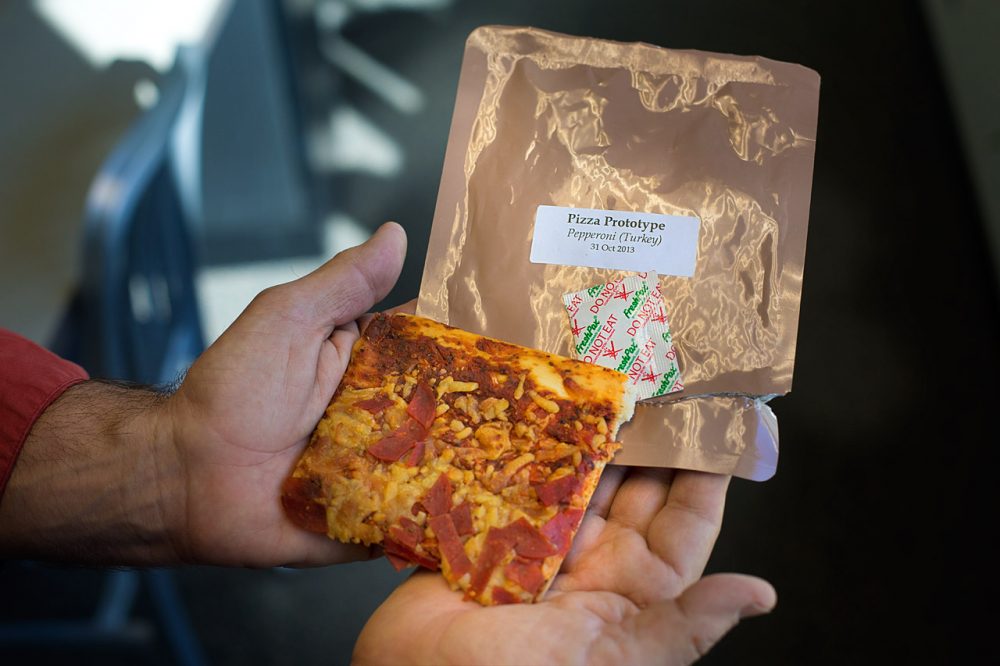Advertisement
Pizza To Go... And Go: Military Develops Slice That Lasts 3 Years
Resume
Pizza is a staple of college all-nighters, political campaigns and, of course, the Super Bowl. Super Bowl Sunday is the busiest day of the year for pizza-makers.
Ninety-three percent of us eat pizza at least once a month, from plain cheese to exotic pies topped with coconut cream — even emu.
However, if you have a taste for something really exotic, head to Natick. Here, researchers are using cutting-edge pizza technology to create state-of-the-art slices — but only for the few, the proud and other members of the U.S. military on combat missions.
'An Army Marches On Its Stomach'
You'd think he would have figured it out in basic training. But no, Napoleon had to learn it the hard way. In 1812 his invasion of Russia reached as far as Moscow.
But Napoleon's supply lines were stretched too thin. With his army starving, he beat a hasty retreat — too late. Hundreds of thousands of French troops died of hunger.
"An army marches on its stomach, so you have to feed the soldiers," says U.S Army combat veteran David Accetta.
Accetta should know. For a quarter of a century, he ate Army chow serving in Iraq, Afghanistan, Bosnia and Kosovo.
"You can't expect soldiers to move to the battlefield without having the right kind of food at the right time," he says.
These days, Accetta is public affairs officer at the Department of Defense Combat Feeding Directorate at the U.S. Army Natick Soldier Research Development and Engineering Center.
It's a mouthful, perhaps appropriate, because here, in a huge test kitchen, researchers whip up foods for future warriors — fighting on land, sea and the air.
Pizza a la Pentagon
Senior food technologist Michele Richardson leads the way past researchers in white lab coats, armed with clipboards who peer into pots and pans.
"This is a pilot plant and this is where we do our product development," Richardson says.
Nobody knows the GI's GI tract like the military food techs at Natick. For 50 years they've been developing special MREs — meals ready to eat — for special missions.
New are "first strike rations": low weight, nutritionally dense, high-energy fingerfoods designed to sustain troops on the front lines — in jungles, deserts and mountaintops.
To pass muster, foods have to stay fresh and have a shelf life of three years at 80 degrees, and six months at 100 degrees, without refrigeration.
"We do have a shelf-stable bagel," Richardson says, "and it's actually part of our first strike ration — asiago cheese, plain, blueberry bagel."
Creating a first strike bagel was tough. But the real challenge, the holy grail of military MREs and the most requested, is pizza.
It's deceptively simple: dough sauce and cheese. But Richardson says making a slice to military specs has been elusive.
"When you combine all of these ingredients, they all have different characteristics," she says. "Sauce has more water than dough, so if you put a sauce on a dough and it has too much moisture, the moisture is going to migrate to the dough, making it very soggy. So one of the things we have to do is manipulate the water activity by adding specific ingredients to the dough, the sauce, get a special cheese, and we have to make sure these water activities complement each other."
A key to perfecting pizza that stays fresh, even after sitting on a shelf for 1,000 days, was the invention of a proprietary packet filled with iron fillings. It soaks up moisture and rusts so the pizza doesn't become a moldy petri dish.
"We have professional taste-testers," Accetta says, "but we also test extensively with the soldiers because they're the ones who will be consuming these, out in field, in the cold in the rain, sitting on a mountainside in Afghanistan, and it has to be good and something they enjoy eating."
For the military, food is far more than fuel. It's a taste of home, a morale booster. In Pentagon-speak: a force multiplier that can amp up a fighter's effort.
And because variety is the spice of life, especially at the front, the prototype pizza comes in plain cheese or pepperoni made from turkey, Richardson says.
"There are some war fighters who don't want to eat pork, there are some countries that won't allow you to bring pork in," she says. "So turkey is an option. It's just an option."
The Army will begin field-testing its pseudo-pepperoni pizza in August.
And of course, if you're going to make pizza for the military, you have to offer delivery.
"These may be airdropped by parachute in remote locations," Accetta says, "or they may be dropped from a helicopter from an altitude of 50 feet without a parachute."
Pizza a la Pentagon. Hopefully, our troops will love it.
